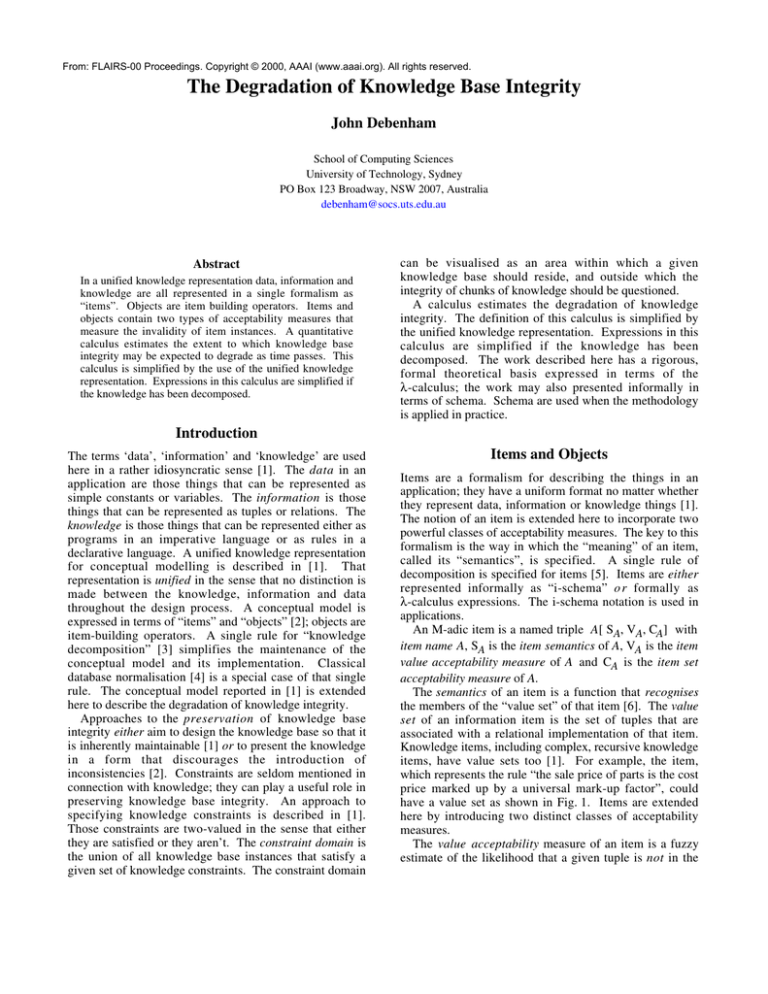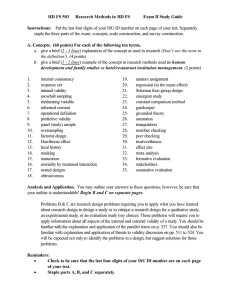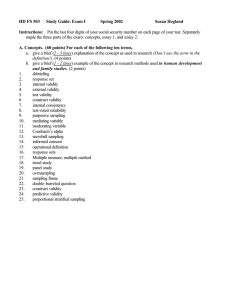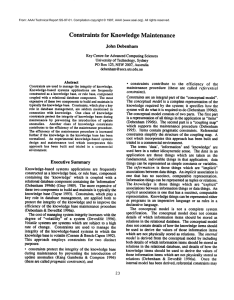
From: FLAIRS-00 Proceedings. Copyright © 2000, AAAI (www.aaai.org). All rights reserved.
The Degradation of Knowledge Base Integrity
John Debenham
School of Computing Sciences
University of Technology, Sydney
PO Box 123 Broadway, NSW 2007, Australia
debenham@socs.uts.edu.au
Abstract
In a unified knowledge representation data, information and
knowledge are all represented in a single formalism as
“items”. Objects are item building operators. Items and
objects contain two types of acceptability measures that
measure the invalidity of item instances. A quantitative
calculus estimates the extent to which knowledge base
integrity may be expected to degrade as time passes. This
calculus is simplified by the use of the unified knowledge
representation. Expressions in this calculus are simplified if
the knowledge has been decomposed.
can be visualised as an area within which a given
knowledge base should reside, and outside which the
integrity of chunks of knowledge should be questioned.
A calculus estimates the degradation of knowledge
integrity. The definition of this calculus is simplified by
the unified knowledge representation. Expressions in this
calculus are simplified if the knowledge has been
decomposed. The work described here has a rigorous,
formal theoretical basis expressed in terms of the
λ-calculus; the work may also presented informally in
terms of schema. Schema are used when the methodology
is applied in practice.
Introduction
The terms ‘data’, ‘information’ and ‘knowledge’ are used
here in a rather idiosyncratic sense [1]. The data in an
application are those things that can be represented as
simple constants or variables. The information is those
things that can be represented as tuples or relations. The
knowledge is those things that can be represented either as
programs in an imperative language or as rules in a
declarative language. A unified knowledge representation
for conceptual modelling is described in [1]. That
representation is unified in the sense that no distinction is
made between the knowledge, information and data
throughout the design process. A conceptual model is
expressed in terms of “items” and “objects” [2]; objects are
item-building operators. A single rule for “knowledge
decomposition” [3] simplifies the maintenance of the
conceptual model and its implementation. Classical
database normalisation [4] is a special case of that single
rule. The conceptual model reported in [1] is extended
here to describe the degradation of knowledge integrity.
Approaches to the preservation of knowledge base
integrity either aim to design the knowledge base so that it
is inherently maintainable [1] or to present the knowledge
in a form that discourages the introduction of
inconsistencies [2]. Constraints are seldom mentioned in
connection with knowledge; they can play a useful role in
preserving knowledge base integrity. An approach to
specifying knowledge constraints is described in [1].
Those constraints are two-valued in the sense that either
they are satisfied or they aren’t. The constraint domain is
the union of all knowledge base instances that satisfy a
given set of knowledge constraints. The constraint domain
Items and Objects
Items are a formalism for describing the things in an
application; they have a uniform format no matter whether
they represent data, information or knowledge things [1].
The notion of an item is extended here to incorporate two
powerful classes of acceptability measures. The key to this
formalism is the way in which the “meaning” of an item,
called its “semantics”, is specified. A single rule of
decomposition is specified for items [5]. Items are either
represented informally as “i-schema” o r formally as
λ-calculus expressions. The i-schema notation is used in
applications.
An M-adic item is a named triple A[ SA, VA, CA] with
item name A, SA is the item semantics of A, VA is the item
value acceptability measure of A and CA is the item set
acceptability measure of A.
The semantics of an item is a function that recognises
the members of the “value set” of that item [6]. The value
set of an information item is the set of tuples that are
associated with a relational implementation of that item.
Knowledge items, including complex, recursive knowledge
items, have value sets too [1]. For example, the item,
which represents the rule “the sale price of parts is the cost
price marked up by a universal mark-up factor”, could
have a value set as shown in Fig. 1. Items are extended
here by introducing two distinct classes of acceptability
measures.
The value acceptability measure of an item is a fuzzy
estimate of the likelihood that a given tuple is not in the
[part/sale-price, part/cost-price, mark-up]
part/sale-price
part/cost-price
mark-up
partdollarpartdollarfactor-%
number amount
number amount
1234
1.48
1234
1.23
1.2
2468
2.81
2468
2.34
1.2
3579
4.14
3579
3.45
1.2
8642
5.47
8642
4.56
1.2
7531
6.80
7531
5.67
1.2
1470
8.14
1470
6.78
1.2
Fig. 1. Value set of the item
[part/sale-price, part/cost-price, mark-up]
item’s value set. This measure is a fuzzy expression of the
form:
1 ...y n •[V (y1,...,y 1 ) º..º V (yn ,..,y n ) º
λy11...y m
A1 1
An 1
mn
m1
mn
1
1
1 ,..,y n )]•
K(y 1 ,..,ym
m
where {A1,..., A1n } aren the components of item A, K is a
fuzzy predicate and º is the fuzzy “min” conjunction.
The set acceptability measure of an item is a fuzzy
estimate of the likelihood that the general structure of the
item’s value set is invalid [7]. This measure is a fuzzy
expression of the form:
[ CA º CA º...º CA º (L)A ]
1
2
n
where º is the fuzzy “min” conjunction and L is a fuzzy
expression constructed as a logical combination of:
• CardA lies in some numerical range;
• Uni(Ai) for some i, 1 ≤ i ≤ n, and
• Can(A i , X) for some i, 1 ≤ i ≤ n, where X is a nonempty subset of {A1 ,..., An } - {Ai };
subscripted with the name of the item A,
“Uni(Ai )” is a fuzzy predicate whose truth value is “the
proportion of the members of the value set of item Ai that
also occur in the value set of item A”. “Can(Ai , X)” is a
fuzzy predicate whose truth value is “in the value set of
item A, the proportion of members of the value set of the
set of items X that functionally determine members of the
value set of item A i ,”. “CardA ” means “the number of
different values in the value set of item A”. The subscripts
identify the item’s components to which that measure
applies.
For example, the semantics of the [part/sale-price,
part/cost-price, mark-up] item is:
λx1x2 y1 y2 z•[ Spart/sale-price(x1, x2 ) º
S part/cost-price(y1, y2 ) º Smark-up(z) º
((x 1 = y 1 ) 8 (x2 = z _ y2))]•
So an item’s semantics specifies what should be in an
implementation, and the two acceptability measures are
measures of invalidity of what is in an implementation. If
an acceptability measure does not detect invalidity to any
level of (fuzzy) significance then this does not imply that
an implementation is valid.
For example, an application could contain a spare-part
thing that is represented by the item part. If spare parts are
identified by their part-number then the semantics of part
is λx•[is-a[x:part-number]]• where the function “:” means
“x if x is in P” and “undefined otherwise”. Suppose that
the generally expected range for part numbers is [0, 2 000].
Then the value acceptability measure for the item part
could be λx•[f(x)]• where:
0
if x < 0
1
if 0 ≤ x ≤ 2 000
x
f(x) =
2 –
if 2 000 < x < 4 000
2 000
0
if x ≥ 4 000
Cardpart is the number of different part-numbers. Suppose
that the generally expected range for Cardpart is less than
100. Then the set acceptability measure, Cpart , for the
item part is a fuzzy predicate; it could be:
if Cardpart ≤ 100
1
Card
part
C part =
if 100 < Cardpart < 200
2 – 100
0
if Cardpart ≥ 200
In this way, value and set acceptability measures are
developed for data items, and similarly for information and
knowledge items.
Items make it difficult to analyse the structure of the
whole application because, for example, two rules that
share the same basic wisdom may be expressed in terms of
quite different components; this could obscure their
common wisdom. To make the inherent structure of
knowledge clear ‘objects’ are introduced as item building
operators [1].
Object names are written in bold italics. Suppose that
the conceptual model already contains the item “part”
which represents spare parts, and the item “cost-price”
which represents cost prices; then the information “spare
parts have a cost price” can be represented by
“part/cost-price” which may be built by applying the
“costs” object to part and cost-price:
part/cost-price = costs(part, cost-price)
In [5] the decomposition of items and objects is
described. Decomposition removes hidden relationships
from the conceptual model. Hidden relationships can
present a maintenance hazard. Here decomposition
simplifies the estimation of knowledge integrity.
Degradation of Knowledge Integrity
The semantics of an item A[ SA, VA, CA ] is a function
that recognises the members of its value set. The value set
is a conceptual notion in the system design. So the value
set of the item A—as in the definition of an M-adic item
above—at time τ is:
1 ...y n : S (y1 ,..,y 1 ,..,y n )
γτ(A) = { y11 ...y m
A 1
m
m
m
1
n
1
n
at time τ }
A knowledge base implementation is a set of knowledge
items and a set of stored relations and data domains
mark-up
tax-rate
1.2
25%
[part/sale-price,
part/cost-price, mark-up]
part/cost-price
part/sale-price
1234
1234
1.23
1.48
[part/sale-price,
part/tax-payable,
tax-rate]
part/tax-payable
1234
0.37
Fig. 2. Real and virtual items
representing some information and data items. Some
information and data items are associated with actual
stored data, and some are not. Knowledge items are not
normally associated with actual stored data. If an item is
associated with actual stored data then it is a real item;
otherwise it is a virtual item. The set of tuples in the
implementation of the real item A is denoted by λα(A)
where α is the time of the most recent modification to
those tuples. Knowledge items may be used to derive
tuples for virtual data and information items. For example,
suppose that the real data item mark-up has a stored data
value mark-up, and that the real information item
part/cost-price has a stored relation part/cost-price. Then
the knowledge item [part/sale-price, part/cost-price, markup]—or an “if-then” implementation of it—may be used to
derive tuples in the relation for the virtual item
part/sale- p r i c e .
Further, the knowledge item
[part/sale-price, part/tax-payable, tax-rate] could then
enable the tuples in the relation for the virtual item
part/tax-payable to be derived. This is illustrated in Fig. 2.
If a virtual item Ai is a component of a knowledge item A
where the tuples (or data values) associated with A i are
derived from { λαj(Aj) : Aj is a component of A, j ≠ i }
using the knowledge A then Ai is derivable and those
tuples (or data values) are called the derived set which is
denoted by λβ(Ai) where β is the time at which the
derivation is performed. This definition is recursive. In
Fig. 2 only part/cost-price, mark-up and tax-rate are stored.
This example shows how the validity of the calculation of
the tuples in the relation for the virtual item
part/tax-payable relies on the validity of those three real
items and on the validity of those two knowledge items.
So if the validity of any of those three real items or either
of those two knowledge items has “degraded” in some way
then that calculation may yield an incorrect result.
For a knowledge base, its implementation may not be
valid because updates that should have been performed
were not, or modifications that should not have been
performed were. The corruption of a knowledge base by
such modifications is not considered here. The failure to
perform updates is considered. So updates are changes
that should have been performed on the implementation of
real items or knowledge items. In addition, incorrect
values may be attributed to a knowledge base
implementation because the derived tuples for some virtual
items were calculated prior to required updates being
performed [8]. At time α the true set for a—real or
λα (part)
part
partnumber
1234
2345
2468
3456
3579
4567
Λτ(part)
part
partnumber
1234
2345
2456
2468
3456
3579
4680
λα (part/cost-price) Λτ(part/cost-price)
part/cost-price
part/cost-price
partdollarpartdollarnumber amount
number amount
1234
1.20
1234
1.20
2345
2.40
2345
2.60
2468
3.60
2456
0.60
3456
4.80
2468
3.80
3579
5.10
3456
4.80
4567
6.30
3579
5.20
4680
0.80
Fig. 3. The implementation and the true set
virtual—item A is the set of tuples that should be
associated with A at time α; it is denoted by Λα (A). In
other words, the implementation is what is either stored or
derived in the knowledge base, the true set is what should
be either stored or derived.
Suppose that the implementation of the real data item
part was stored at time α. Then at a subsequent time τ the
implementation and the true set may be as shown on the
left side of Fig. 3. In that Figure the implementation for
the data item part contains the part number “4567” that
should not be there, and does not contain two part numbers
which should be there. Suppose that the implementation
for the real information item part/cost-price was stored at
time α. Then at a subsequent time τ the implementation
and the true set may be as shown on the right side of Fig. 3.
Likewise the implementation and the true set of a
knowledge item may contain tuples that should not be
there, and may not contain tuples that should be there.
Fig. 2 shows a knowledge base implementation
consisting of two knowledge items, three information items
and two data items. If the design and implementation are
correct then the tuples associated with each real or virtual
item will be the same as that item’s true set.
Item and Object Validity
At time τ, the true set Λτ(A) and λ α (A), α ≤ τ, of item A
may not be the same [9]. The implementation of a real
item is “correct” as long as its tuples have been correctly
stored and maintained [10]. The derived set of a virtual
item is “correct” as long as the knowledge used to derive
the tuples for that item has been correctly maintained and
the stored data used by that knowledge has been correctly
maintained.
In reality we may hope that the
implementation is correct, and expect that it is incorrect
[11]. To measure the extent that the implementation or the
derived set are the same as the true set, let pX/Y be the
proportion of those elements in set X that are also in set Y.
Then the difference measure:
∆(A, B) =
pA/B _ pB/A
√
is unity if both sets are identical and is zero if one set
contains no elements from the other; the square root
ensures that this measure retains linearity with measured
proportion. For example, if each set contains exactly half
of the members of the other set then the value of this
measure is 0.5. The value of the difference measure is not
necessarily equal to the proportion of valid members in
either set because the difference measure takes account of
those elements that are not in each set but should be there.
The validity of a real or virtual item A at time τ is:
δA(τ) = ∆(λτ(A), Λα (A))
where τ ≥ α and the difference measure ∆ is as defined
above. 0 ≤ δA(τ) ≤ 1. If δA(τ) = 1 then item A is valid. If
δA(τ) = 0 then the set of tuples associated with item A
contains no tuples that it should contain and A is
completely invalid.
The knowledge item [part/sale-price, part/cost-price,
mark-up] is built by applying the knowledge object markup-rule to the three items part/sale-price, part/cost-price
and mark-up. That knowledge item may be used to derive
tuples for the information item part/sale-price. The
accuracy of these derived tuples relies on the
implementation of the two real items mark-up and
part/cost-price being accurate and on the knowledge object
mark-up-rule being accurate. The integrity of these items
and objects is expected to degrade as time progresses.
If we know precisely what knowledge degradation has
occurred then we can usually rectify it [12]. In practice we
tend to have some loose expectation ε of the validity δ.
For example, we may expect that “within a year the whole
part/cost-price relation will be out of date”. So our
expectation for the validity of the part/cost-price item may
be represented by a function with a linear decay of one
year’s extent. Also, we may expect that “as the ‘types’ of
parts are redesignated, the integrity of the part/type relation
will degrade decreasingly over time so that in a year
roughly half of the relation will be out of date and in a
‘very long time’ the whole relation will be out of date”. So
our expectation for the degradation of the part/type item
may be represented by a function with an exponential
decay with a half-life of one year. The validity estimates
for these two examples are:
1 – τ if 0 ≤ τ ≤ 1
εpart/cost-price(τ) =
0
otherwise
–τ
ε
(τ) = 2 for τ ≥ 0
part/type
The validity of an object will contribute to the validity of
any item generated by that object. But objects do not have
a value set or an implementation. The validity of the item
A, generated using object B, A = B( C, D, E, F) may be
analysed completely in terms of the validity of items C, D,
E and F and the validity of object B. In other words, if
items C, D, E and F are valid then the validity of item A
will be attributable entirely to the validity of object B. So
the validity of an object is the validity of any item
generated by that object when applied to a set of valid
items.
Propagating Validity Estimates
It would be convenient if:
εob(cc, dd) (τ) = εob(τ)
_
εcc(τ)
_
εdd(τ)
but this product rule is not valid in general because the
validity of the components—in the above example the
components are cc and dd—may be logically dependent.
This product rule is valid if the validity of the object ob
and the validity of the two component items are all
independent. If the validity of X is independent of the
validity of Y then ( εX(τ) | εY(τ) ) = εX(τ). If the validity
of X is determined by the validity of Y then
( εX(τ) | εY(τ) ) = εY(τ).
Suppose that object ob is applied to a set of n component
items C = {cc, D} where cc is a component item and D is a
set of n-1 component items. The general rule for
propagating validity estimates through an object operator
is:
|=
εob(C)(τ) = εob(τ) _ ( εC(τ) | εob(τ) )
= εC(τ) _ ( εob(τ) | εC(τ) )
where ( εC(τ) | εob(τ) ) is “an estimate of the validity of
the set of n component items C at time τ given that the
estimate of the validity of object ob at time τ is εob(τ).” If
the conceptual model has been decomposed then
( εC(τ) | εob(τ) ) = εC(τ). To propagate validity estimates
across a set of component items, suppose that the set C is a
set of n component items as above. The general recursive
rule for propagating validity estimates over such a set is:
|=
ε{cc, D}(τ) = εcc(τ)
_
( εD(τ) | εcc(τ) )
where ( εD(τ) | εcc(τ) ) is “an estimate of the validity of
the set of n-1 component items D at time τ given that the
estimate of the validity of the component item cc at time τ
is εcc(τ).” In general ( εD(τ) | εcc(τ) ) ≠ εD(τ) even if the
conceptual model has been decomposed. Now suppose
that item cc is virtual and that it is derivable from the set of
items D using knowledge item ob( cc, D ), ie that
Can( cc, D ) = 1 in ob( cc, D ). Then the validity of item cc
depends on the validity of object ob and on the validity of
the items in the set D. Estimates of these validities are
propagated by:
|=
εcc(τ) = εob(τ)
_
( εD(τ) | εob(τ) )
If the conceptual model has been decomposed then
( εD(τ) | εob(τ) ) = εD(τ).
The three rules above for propagating validity estimates
follow from the definition of item validity. These three
rules lead to complex expressions for validity estimates
due to the quantity of conditional expressions—ie
expressions involving “|”. But the quantity of these
conditional expressions may be reduced.
If the knowledge base has been decomposed [1] and if
the sub-item relationships have been reduced to sub-type
relationships [4] between data items then the object
operators and the basis items in the conceptual model are
independent with the possible exception of sub-item
relationships between data items [1]. So if the knowledge
base has been decomposed and there are no sub-item
relationships between data items then all the conditional
expressions may be removed. For example, if the
knowledge base has been decomposed and there are no
sub-item relationships between data items then the validity
estimate for the virtual information item part/tax-payable
is:
εpart/tax-payable(τ) = εtax-rule(τ)
_ ( ε{part/sale-price, tax-rate}(τ) | εtax-rule(τ) )
= εtax-rule(τ) _ ε{part/sale-price, tax-rate}(τ)
= εtax-rule(τ) _ εpart/sale-price(τ)
_ ( εtax-rate(τ) | εpart/sale-price(τ) )
= εtax-rule(τ) _ εpart/sale-price(τ) _ εtax-rate(τ)
= εtax-rule(τ) _ εmark-up-rule(τ)
_ ( ε{part/cost-price, mark-up}(τ) | εmark-up-rule(τ) )
_ εtax-rate(τ)
= εtax-rule(τ) _ εmark-up-rule(τ)
_ εpart/cost-price(τ) _ εmark-up(τ) _ εtax-rate(τ)
If sub-item relationships are present or if the conceptual
model has not been decomposed then the calculations
become more involved. For example, suppose the
supervisor data item is a sub-item of the person data item.
Consider the real person/supervisor item; the
implementation of which is populated with 2-tuples
(person-id, person-id) where the second person is the
“supervisor” of the first. Suppose that this item is built by
applying the super information object to the data items
person and supervisor:
person/supervisor = super( person, supervisor )
then the validity estimate of the person/supervisor
information item will be:
εsuper(person, supervisor)(τ)
= ε{person, supervisor}(τ)
_ ( εsuper(τ) | ε{





